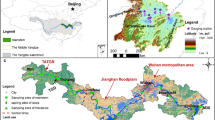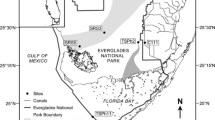Abstract
The composition and biodegradability of streamwater dissolved organic matter (DOM) varies with source material and degree of transformation. We combined PARAFAC modeling of fluorescence excitation–emission spectroscopy and biodegradable dissolved organic carbon (BDOC) incubations to investigate seasonal changes in the lability of DOM along a soil-stream continuum in three soil types: bog, forested wetland and upland forest. The percent BDOC ranged from 7 to 38% across all sites, and was significantly greater in soil compared to streamwater in the bog and forested wetland, but not in the upland forest. The percent BDOC also varied significantly over the entire sampling period in soil and streamwater for the bog and forested wetland, as BDOC peaked during the spring runoff and was lowest during the summer months. Moreover, the chemical quality of DOM in wetland soil and streamwater was similar during the spring runoff and fall wet season, as demonstrated by the similar contribution of protein-like fluorescence (sum of tyrosine and tryptophan fluorescence) in soil water and in streams. These findings suggest that the tight coupling between terrestrial and aquatic ecosystems is responsible for the delivery of labile DOM from wetland soils to streams. The contribution of protein-like fluorescence was significantly correlated with BDOC (p < 0.001) over the entire sampling period indicating DOM is an important source of C and N for heterotrophic microbes. Taken together, our findings suggest that the production of protein-rich, labile DOM and subsequent loss in stream runoff might be an important loss of labile C and N from coastal temperate watersheds.









Similar content being viewed by others
References
Agren A, Buffam I, Jansson M, Laudon H (2007) Importance of seasonality and small streams for the landscape regulation of dissolved organic carbon export. J Geophys Res 112:G0300. doi:1029/2006JG000381.2007
Aitkenhead-Peterson JA, McDowell WH, Neff JC (2003) Sources, production, and regulation of allochthonous DOM inputs to surface waters. In: Findlay SEG, Sinsabaugh RL (eds) Aquatic ecosystems: interactivity of dissolved organic matter. Elsevier, New York, pp 25–70
Baker A (2001) Fluorescence excitation–emission matrix characterization of some sewage-impacted rivers. Environ Sci Technol 35:948–953
Billet MF, Deacon CM, Palmer SM, Dawson JC, Hope D (2006) Connecting organic carbon in streamwater and soils in a peatland catchment. J Geophy Res 111:G02010. doi:10.1029/2005JG000065
Boyer JN, Groffman PM (1996) Bioavailability of water extractable organic carbon fractions in forest and agricultural soil profiles. Soil Biol Biochem 28(6):783–790
Burdige DJ, Kline SW, Chen W (2004) Fluorescent dissolved organic matter in marine sediment pore waters. Mar Chem 89:289–311
Chaloner DT, Martin KM, Wipfli MS, Ostrom PH, Lamberti GA (2002) Marine carbon and nitrogen in south-eastern Alaskan stream food webs. Evidence from artificial and natural streams. Can J Fish Aquat Sci 59:1257–1265
Chapin FS III, Moilanen L, Kielland K (1993) Preferential use of organic nitrogen for growth by a non-mycorrhizal arctic sedge. Nature 361:150–152
Coble P (1996) Characterization of marine and terrestrial DOM in seawater using excitation–emission matrix spectroscopy. Mar Chem 51:325–346
Cory RM, McKnight DM (2005) Fluorescence spectroscopy reveals ubiquitous presence of oxidized and reduced quinones in DOM. Environ Sci Technol 39:8142–8149
Cowardin LM, Carter V, Golet FC, La Roe ET (1979) Classification of wetlands and deepwater habitats of the United States. US Fish and Wildlife Service, Office of the Biological Services, Washington (FWS/OBS-79/31)
Dawson JJC, Bakewell C, Billett MF (2001) Is in-stream processing an important control on spatial changes in carbon fluxes in headwater catchments. Sci Total Environ 265:153–167
Dawson JJC, Billett MF, Hope D, Palmer SM, Deacon CM (2004) Sources and sinks of aquatic carbon in a peatland stream continuum. Biogeochemistry 70:71–92
Eigenvector Research Inc. (2006) Version 3.7. Eigenvector Research Inc., Wenatchee, WA
Fastie C (1995) Causes and ecosystem consequences of multiple pathways of primary succession at Glacier Bay, Alaska. Ecology 76:1899–1916
Fellman JB, D’Amore DV (2007) Nitrogen and phosphorus mineralization in three wetland types in southeast Alaska. Wetlands 27(1):44–53
Fellman JB, D’Amore DV, Hood E, Boone RD (2008) Fluorescence characteristics and biodegradability of dissolved organic matter in forest and wetland soils from coastal temperate watersheds in SE Alaska. Biogeochemistry 88:169–184
Fellman JB, Hood E, Edwards RT, D’Amore DV (2009) Changes in the concentration, biodegradability and fluorescent properties of dissolved organic matter during stormflows in coastal temperate watersheds. J Geophys Res 114:G01021. doi:10.1029/2008JG000790
Fenner N, Freeman C, Reynolds B (2005) Observations of a seasonally shifting thermal optimum in peatland carbon-cycling processes; implications for the global carbon cycle and soil enzyme methodologies. Soil Biol Biochem 37:1814–1821
Fitzgerald DF, Price JS, Gibson JJ (2003) Hillslope-swamp interactions and flow paths in a hypermaritime rainforest, British Columbia. Hydrol Process 17:3005–3022
Francoeur SN (2001) Meta-analysis of lotic nutrient amendment experiments: detecting and quantifying subtle responses. J N Am Benthol Soc 20:358–368
Fraser CJD, Roulet NT, Moore TR (2001) Hydrology and dissolved organic carbon biogeochemistry in an ombrotrophic bog. Hydrol Process 15:3151–3166
Geller A (1986) Comparison of mechanisms enhancing biodegradability of refractory lake water constituents. Limnol Oceanogr 31:755–764
Gorham E (1991) Northern peatlands: role in the carbon cycle and probable response to climatic warming. Ecol App 1(2):182–195
Green SA, Blough NV (1994) Optical absorption and fluorescence properties of chromophoric dissolved organic matter in natural waters. Limnol Oceanogr 39:1903–1916
Hedin LO, Armesto JJ, Johnson AH (1995) Patterns of nutrient loss from unpolluted, old growth temperate forests—evaluation of biogeochemical theory. Ecology 76:493–509
Holmes RM, McClelland JW, Raymond PA, Frazer BB, Peterson BJ, Stieglitz M (2008) Lability of DOC transported by Alaskan Rivers to the Arctic Ocean. Geophys Res Lett 35:L03402. doi:10.1029/2007GL032837
Hood E, Williams MW, Caine N (2003) Landscape controls on organic and inorganic nitrogen leaching across an alpine/subalpine ecotones, Green Lakes Valley, Colorado front range. Ecosystems 6:31–45
Hood E, Williams MW, McKnight DM (2005) Sources of dissolved organic matter (DOM) in a Rocky Mountain stream using chemical fractionation and stable isotopes. Biogeochemistry 74:231–255
Hood E, Fellman JB, Edwards RT (2007) Salmon influences on dissolved organic matter in a coastal temperate brown-water stream. Limnol Oceanogr 52(4):1580–1587
Ivarson KC, Sowden FJ (1966) Effect of freezing on the free amino acids in soil. Can J Soil Sci 46:115–120
Jaeger CHIII, Monson RK, Fisk MC, Schmidt SK (1999) Seasonal partitioning of nitrogen by plants and soil microorganisms in an alpine ecosystem. Ecology 80(6):1883–1891
Kalbitz K, Schwesig D, Rethemeyer J, Matzner E (2005) Stabilization of dissolved organic matter by sorption to the mineral soil. Soil Biol Biochem 37:1319–1331
Kaplan LA, Bott TL (1983) Microbial heterotrophic utilization of dissolved organic matter in a piedmont stream. Freshwater Biol 13:363–377
Kaplan LA, Newbold JD, Van Horn DJ, Dow CL, Aufdenkampe AK, Jackson JK (2006) Organic matter transport in New York City drinking-water-supply watersheds. J N Am Benthol Soc 25(4):912–927
Lytle CR, Perdue EM (1981) Free, proteinaceous, and humic-bound amino acids in river water containing high concentrations of aquatic humus. Environ Sci Technol 15(2):224–228
McDowell WH (1985) Kinetics and mechanisms of dissolved organic carbon retention in a headwater stream. Biogeochemistry 1:329–352
McDowell WH, Likens GE (1988) Origin, composition, and flux of dissolved organic carbon in the Hubbard Brook Valley. Ecol Monogr 58(3):177–195
McKnight DM, Hornberger GM, Bencala KE, Boyer EW (2002) In-stream sorption of fulvic acid in an acidic stream: a stream-scale transport experiment. Water Resourc Res 38(1):1005. doi:10.1029/2001WR000269
Michaelson GJ, Ping CL, Kling GW, Hobbie JE (1998) The character and bioactivity of dissolved organic matter at thaw and in the spring runoff waters of the arctic tundra north slope, Alaska. J Geophy Res 103(D22):28939–28946
Mulholland PJ (2003) Sources, production, and regulation of allochthonous dissolved organic matter inputs to surface waters. In: Findlay SEG, Sinsabaugh RL (eds) Aquatic ecosystems: interactivity of dissolved organic matter. Elsevier, New York, pp 139–160
Murphy J, Riley JP (1962) A modified single solution method for the determination of phosphate in natural waters. Anal Chim Acta 27:31–36
National Wetlands Working Group (NWWG) (1988) Wetlands of Canada. Environment Canada, Sustainable development branch, Ottawa. Ecological Land Classification Series 24
Neff JC, Asner GP (2001) Dissolved organic carbon in terrestrial ecosystems: synthesis and a model. Ecosystems 4:29–48
Neff JC, Chapin FS III, Vitousek PM (2003) Breaks in the nitrogen cycle: dissolved organic nitrogen in terrestrial ecosystems. Front Ecol Environ 1(4):205–211
Ohno T, Bro R (2006) Dissolved organic matter characterization using multiway spectral decomposition of fluorescence landscapes. Soil Sci Soc Am J 70:2028–2037
Pellerin BA, Wollheim WM, Hopkinson CS, Williams MR, Vorosmarty CJ, Daley ML (2004) Role of wetland and developed land use on dissolved organic nitrogen concentrations and DON/TDN in northeastern US rivers and streams. Limnol Oceanog 49(4):910–918
Pinney ML, Westerhoff PK, Baker L (2000) Transformations in dissolved organic carbon through constructed wetlands. Water Res 34(6):1897–1911
SAS Institute (2003) Version 9.1. SAS Institute Inc., Cary, NC, USA
Schiff SL, Aravena R, Trumbore SE, Hinton MJ (1997) Export of DOC from forested catchments on the Precambrian Shield of Central Ontario: clues from 13C and 14C. Biogeochemistry 36:43–65
Schimel JP, Clein JS (1996) Microbial response to freeze–thaw cycles in tundra and taiga soils. Soil Biol Biochem 28(8):1061–1066
Stedmon CA, Markager S (2005) Resolving the variability in dissolved organic matter fluorescence in a temperate estuary and its catchment using PARAFAC analysis. Limnol Oceanogr 50(2):686–697
Stedmon CA, Markager S, Bro R (2003) Tracing DOM in aquatic environments using a new approach to fluorescence spectroscopy. Mar Chem 82:239–254
Striegl RG, Aiken GR, Dornblaser MM, Raymond PA, Wickland KP (2005) A decrease in discharge-normalized DOC export by the Yukon River during summer through autumn. Geophys Res Lett 32:L21413. doi:10.1029/2005GL024413
Tierney GL, Fahey TJ, Groffman PM, Hardy JP, Fitzhugh RS, Driscoll CT (2001) Soil freezing alters fine root dynamics in a northern hardwood forest. Biogeochemistry 56:175–190
Tranvik LJ, Jorgensen NOG (1995) Colloidal and dissolved organic matter in lake water: carbohydrate and amino acid composition, and ability to support bacterial growth. Biogeochemistry 30:77–97
USDA (1997) Tongass National Forest Land and Resource Management Plan, R10-MV-338dd. USDA Forest Service, Region 10, Juneau, AK, USA
Ussiri DAN, Johnson CE (2003) Characterization of organic matter in a northern hardwood forest soil by 13C NMR spectroscopy and chemical methods. Geoderma 111:123–149
Valderrama JC (1981) The simultaneous analysis of total nitrogen and total phosphorus in natural waters. Mar Chem 10:109–122
Vannote RL, Minshall GW, Cummins KW, Sedell JR, Cushing CE (1980) The river continuum concept. Can J Fish and Aquat Sci 37:130–136
Weishaar JL, Aiken GR, Bergamaschi BA, Fram MS, Fujil R (2003) Evaluation of specific ultraviolet absorbance as an indicator of the chemical composition and reactivity of dissolved organic carbon. Environ Sci Technol 37:4702–4708
Wickland KP, Neff JC, Aiken GR (2007) Dissolved organic carbon in Alaskan boreal forest: sources, chemical character and biodegradability. Ecosystems 10:1323–1340
Wiegner TN, Seitzinger SP (2004) Seasonal bioavailability of dissolved organic carbon and nitrogen from pristine and polluted freshwater wetlands. Limnol Oceanogr 49(5):1703–1712
Worrall F, Burt T, Adamson J (2003) Controls on the chemistry of runoff from an upland peat catchment. Hydrol Process 17:2063–2083
Acknowledgments
The authors wish to acknowledge Karen Michael, Jacob Berkowitz, Adelaide Johnson, Erik Norberg, Mark Lukey, Denise Elston, Nicholas Bonzey and Andy Bookter for their tremendous laboratory and field assistance. This study was funded by the US Department of Agriculture National Research Initiative, grant number 2005-35102-16289, the USDA Forest Service, Resource Management and Productivity Program and the Aquatic and Land Interactions Program at the Pacific Northwest Research Station in Juneau, AK. The use of trade or firm names in this publication is for reader information and does not imply endorsement by the US Department of Agriculture of any product or service.
Author information
Authors and Affiliations
Corresponding author
Rights and permissions
About this article
Cite this article
Fellman, J.B., Hood, E., D’Amore, D.V. et al. Seasonal changes in the chemical quality and biodegradability of dissolved organic matter exported from soils to streams in coastal temperate rainforest watersheds. Biogeochemistry 95, 277–293 (2009). https://doi.org/10.1007/s10533-009-9336-6
Received:
Accepted:
Published:
Issue Date:
DOI: https://doi.org/10.1007/s10533-009-9336-6




